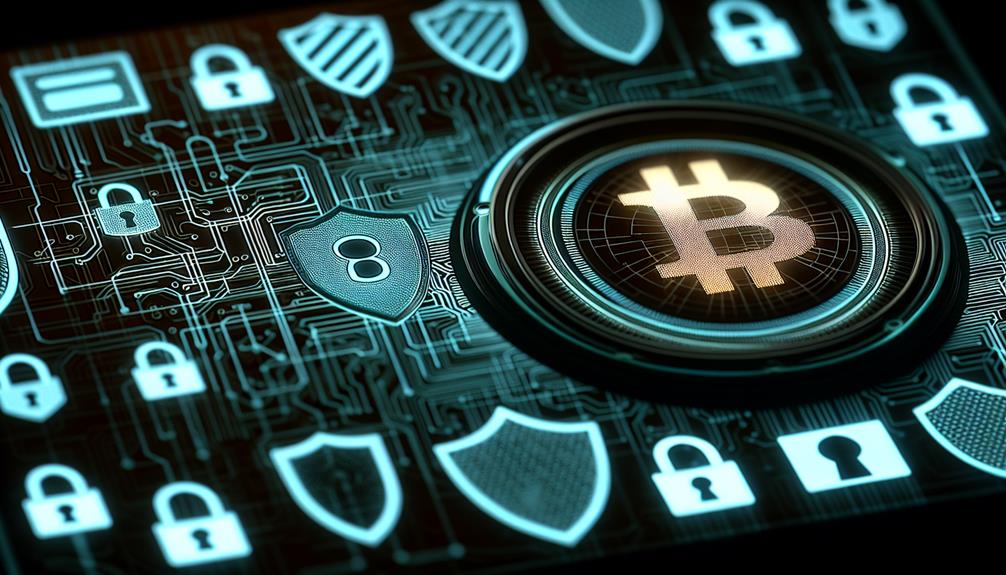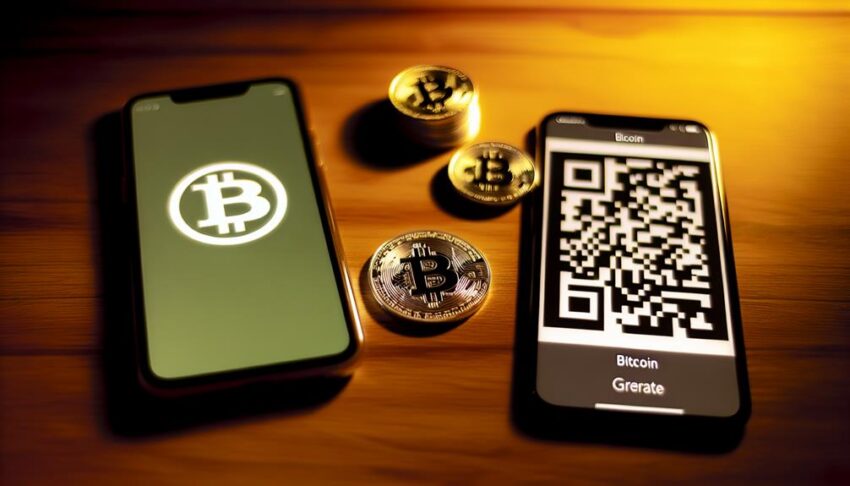Is it really as simple to pay with Bitcoin as some claim, or are there hidden complexities? You might find that while the process appears straightforward, understanding the nuances can make a significant difference in your experience. From selecting the right wallet to ensuring secure transactions, there's much more to contemplate. If you're curious about how to navigate this digital currency landscape effectively, you may want to explore the essential steps that can enhance your confidence in using Bitcoin for everyday purchases.
Understanding Bitcoin Basics
Bitcoin, often referred to as digital gold, is a decentralized cryptocurrency that operates on a peer-to-peer network, enabling secure and transparent transactions without the need for intermediaries like banks. At its core, Bitcoin utilizes blockchain technology, which is a distributed ledger system that records all transactions across a network of computers. This guarantees that each transaction is verified and immutable, greatly reducing the risk of fraud.
When you engage with Bitcoin, you benefit from several cryptocurrency advantages. One of the most notable is the lower transaction fees compared to traditional banking systems. Since there are no intermediaries involved, you're not subjected to high fees typically associated with bank transfers or credit card payments. Additionally, Bitcoin transactions can be processed 24/7, offering flexibility that traditional banking hours do not.
Another key benefit is the increased privacy and security. While transactions are recorded on the blockchain, your personal information isn't tied to your Bitcoin address, providing an additional layer of anonymity. This privacy aspect can be especially appealing in a world where data breaches are increasingly common.
Moreover, Bitcoin's decentralized nature means that it's not controlled by any government or financial institution, providing users with greater control over their funds. As you explore Bitcoin, understanding these fundamental aspects of blockchain technology and the inherent cryptocurrency benefits will empower you to make informed decisions about your digital transactions.
Setting Up a Bitcoin Wallet
When setting up a Bitcoin wallet, you'll first need to choose the type that best suits your needs, such as a mobile app or hardware wallet. After selecting a wallet, downloading the appropriate application is straightforward, but it's essential to prioritize security during this process. Finally, implementing robust security measures will protect your Bitcoin from potential threats and unauthorized access.
Choosing a Wallet Type
As you commence your journey to use Bitcoin, selecting the right wallet type is essential for both security and convenience. There are several wallet types to evaluate, each with distinct wallet features that cater to varying needs.
First, you have hardware wallets—physical devices that store your private keys offline. They offer robust security against online threats, making them ideal for long-term storage. Next, software wallets come in two forms: desktop and mobile. Desktop wallets provide more control and security but might be vulnerable to malware. Mobile wallets, on the other hand, are user-friendly and accessible on-the-go, but make sure you use reputable apps to avoid security risks.
Another option is web wallets, which operate in the cloud. They're convenient for quick transactions, but they require trust in the service provider as your private keys are stored online. Finally, paper wallets offer a completely offline solution, though they can be difficult to manage and carry.
Ultimately, the choice depends on how you plan to use Bitcoin. Assess your needs for security, accessibility, and user-friendliness to determine which wallet type best fits your situation.
Downloading the App
To begin setting up your Bitcoin wallet, you'll need to download the appropriate app that suits your chosen wallet type. Bitcoin wallets generally fall into three categories: software, hardware, and online wallets. Each type has its own app, and you'll want to guarantee you select one that aligns with your needs.
When choosing an app, consider its features. Look for functionalities like multi-currency support, transaction history, and ease of use. Some apps also offer built-in exchanges, which can simplify the process of converting Bitcoin to fiat currency.
App compatibility is another important factor. Confirm the app you select is compatible with your device—whether you're using a smartphone, tablet, or desktop computer. Check for compatibility with your operating system as well, whether it's iOS, Android, Windows, or macOS.
Before downloading, read through user reviews and ratings to gauge performance and reliability. Understanding these aspects will help you make a more informed decision, guaranteeing the app you choose not only meets your immediate needs but also provides a secure and efficient Bitcoin transaction experience.
Securing Your Wallet
Once you've selected and downloaded a Bitcoin wallet app, the next step involves securing your wallet to protect your funds from unauthorized access. One of the most effective ways to do this is through wallet encryption. This feature adds a layer of security by requiring a password to access your wallet, ensuring that even if someone gains access to your device, they can't access your Bitcoin without your password.
Another robust option is using multi-signature wallets. These wallets require multiple private keys to authorize a transaction, which greatly reduces the risk of theft. For example, a 2-of-3 multi-signature setup means that two out of three authorized keys must sign off on a transaction.
Here's a quick comparison of security features:
| Feature | Description | Benefits |
|---|---|---|
| Wallet Encryption | Requires a password to access the wallet | Protects against unauthorized access |
| Multi-Signature Wallets | Requires multiple keys for transaction approval | Enhances security and trust |
| Backup & Recovery | Creates a secure backup of your wallet | Prevents loss of funds if device is lost |
Acquiring Bitcoin

To acquire Bitcoin, you can either buy it from exchanges or earn it through mining. Buying from exchanges provides immediate access to Bitcoin, while mining involves validating transactions and requires significant computational resources. Each method has its own advantages and considerations, so it's crucial to evaluate which aligns best with your goals and resources.
Buying From Exchanges
Acquiring Bitcoin through exchanges involves traversing a digital marketplace where various cryptocurrencies are bought and sold. To begin, you'll need to choose a reliable exchange platform. Popular options include Coinbase, Binance, and Kraken, each offering different features and fee structures. Once you've selected a platform, you'll typically need to create an account and provide identification to comply with regulatory requirements.
After setting up your account, you can fund it using traditional currencies like USD or EUR. Keep in mind that market fluctuations can notably impact Bitcoin's price, so timing your purchase can be essential. Monitoring price trends and setting up alerts can help you make informed decisions.
When you decide to buy, you'll place an order, which can be a market order or a limit order, depending on your strategy. A market order buys at the current price, while a limit order allows you to specify a price at which you're willing to buy. Once the transaction completes, your Bitcoin will be stored in the exchange's wallet, or you can transfer it to a private wallet for increased security. Always remember to understand the risks involved, as the cryptocurrency market is volatile.
Earning Through Mining
Earning Bitcoin through mining involves utilizing specialized hardware to solve complex mathematical problems that secure the network and validate transactions. To get started, you'll need to invest in appropriate mining hardware, such as ASIC miners, which are designed specifically for Bitcoin mining. The choice of hardware greatly impacts your mining profitability, as more efficient machines yield higher returns over time.
Once you've acquired the right hardware, you can join a mining pool, which combines your resources with other miners to increase the chances of earning Bitcoin. This collaborative approach can make mining more profitable, as rewards are distributed based on each member's contribution.
It's also vital to take into account electricity costs, as they can eat into your profits. Your mining profitability depends on the balance between hardware performance, energy consumption, and Bitcoin's market price. Regularly monitoring these factors will help you assess whether your mining efforts are worthwhile.
Lastly, keep an eye on network difficulty, which adjusts approximately every two weeks. As more miners join, it can become increasingly challenging to earn Bitcoin, so staying informed about market trends and mining technology is essential for optimizing your efforts.
Finding Merchants That Accept Bitcoin
As you immerse yourself in the world of Bitcoin transactions, finding merchants that accept this cryptocurrency can sometimes feel like searching for a needle in a haystack. However, several resources can simplify your quest. One of the most effective methods is to consult merchant directories specifically designed to list businesses that accept Bitcoin. Websites like CoinMap and SpendBitcoins allow you to search for local businesses in your area that have embraced this digital currency.
These directories typically provide visual maps and filters to help you locate merchants by category, which can streamline your search considerably. For example, you might find restaurants, cafes, retailers, and service providers, all enthusiastic to accept Bitcoin in exchange for goods and services.
Additionally, contemplate reaching out to local businesses directly. Many establishments may not advertise their acceptance of Bitcoin prominently but might be open to it if you inquire. This approach not only helps you find places to spend your Bitcoin but also encourages local businesses to reflect on adopting cryptocurrency as a payment option.
Another strategy is to join local cryptocurrency communities or forums where members often share recommendations about businesses that accept Bitcoin. Engaging with these groups can provide insights into the evolving landscape of cryptocurrency adoption in your area.
Making Online Purchases

Once you've identified merchants that accept Bitcoin in your area, the next step involves making online purchases using this cryptocurrency. The process is generally straightforward, but understanding the nuances of transaction fees and merchant integration can enhance your experience.
When you're ready to make a purchase, follow these steps:
- Select Bitcoin as your payment method: During checkout, choose Bitcoin from the list of payment options. Verify the merchant has proper integration for cryptocurrency payments, as this affects transaction speed and accuracy.
- Generate a payment address or QR code: The merchant will display a Bitcoin address or a QR code. If you're using a wallet app, you can scan the QR code directly to avoid manual entry errors.
- Confirm the transaction: After entering the amount and sending the Bitcoin, confirm the transaction details. Be mindful of any transaction fees that may apply, as these can vary depending on the network congestion and the specific wallet you're using.
Keep in mind that while Bitcoin transactions are generally faster than traditional banking methods, the integration level of the merchant's payment system can influence the overall experience. Some merchants may have optimized their systems for quicker processing, while others might take longer due to outdated integration processes. Always check for confirmation of your transaction, and don't hesitate to reach out to customer support if you encounter issues.
Paying in Brick-and-Mortar Stores
Paying with Bitcoin in brick-and-mortar stores can be an efficient way to leverage your cryptocurrency while enjoying a traditional shopping experience. Many retailers are adopting cryptocurrency payment systems, making it easier than ever for you to use Bitcoin for in-person transactions. To get started, you'll need a digital wallet that supports Bitcoin and is compatible with the store's payment system.
When you're ready to make a purchase, simply inform the cashier that you'll be paying with Bitcoin. They'll provide you with a QR code that corresponds to the transaction amount. Using your wallet app, scan the QR code, and you'll initiate a payment that typically functions as a contactless payment. This method not only speeds up the transaction process but also minimizes physical contact, aligning with modern payment trends.
Once you've scanned the code and confirmed the payment, the transaction will undergo payment verification. This process involves the Bitcoin network validating the transaction to guarantee its legitimacy. Although this phase might take a few moments, you'll receive a confirmation once the payment is successfully processed. Keep in mind that transaction times can vary based on network congestion.
Security Tips for Bitcoin Transactions

When it comes to securing your Bitcoin transactions, understanding potential vulnerabilities is crucial for protecting your assets. By being proactive, you can mitigate risks associated with both transaction privacy and wallet security. Here are some essential tips to take into account:
- Use wallet encryption: Confirm your wallet is encrypted. This adds an extra layer of security, making it considerably harder for unauthorized users to access your funds. Passwords should be complex and unique, as simple passwords are easily compromised.
- Enable two-factor authentication (2FA): If your wallet provider offers 2FA, always activate it. This feature requires a second verification form, usually through your mobile device, making it much more difficult for hackers to gain access to your account.
- Be cautious with public Wi-Fi: Avoid conducting Bitcoin transactions over public Wi-Fi networks. These networks can be easily intercepted, exposing your sensitive information. If you must use public Wi-Fi, think about utilizing a Virtual Private Network (VPN) for added security.
Frequently Asked Questions
Can I Get a Refund When I Pay With Bitcoin?
You can get a refund when paying with Bitcoin, but it depends on the merchant's refund policies. Not all merchants accept Bitcoin or offer refunds, so it's essential to check their terms before making a purchase.
Are There Transaction Limits When Using Bitcoin?
Yes, there are transaction limits when using Bitcoin, often influenced by wallet security measures and transaction fees. These limits can vary based on the platform, so it's essential to check your wallet's specific guidelines.
What Happens if I Lose My Bitcoin Wallet Access?
If you've lost access to your bitcoin wallet, recovery's often impossible without backups. Implementing robust security measures beforehand, like seed phrases, is essential to safeguard against this frustrating scenario and guarantee peace of mind.
How Do Exchange Rates Affect Bitcoin Payments?
Exchange rates greatly influence your Bitcoin payments. Due to exchange volatility, the value can fluctuate rapidly, impacting payment security. You'll need to monitor rates closely to guarantee your transactions maintain their intended value and security.
Is Bitcoin Payment Taxable in My Country?
When considering bitcoin regulations, you're likely to find that most countries classify cryptocurrencies as assets, meaning tax reporting is necessary. You should consult a local tax professional to guarantee compliance with your jurisdiction's laws.
Conclusion
In the ever-evolving landscape of digital finance, paying with Bitcoin symbolizes empowerment and independence. By embracing this innovative currency, you're not just making transactions; you're joining a revolution that challenges traditional banking systems. As you navigate this new frontier, remember that security is your shield. By safeguarding your wallet and conducting transactions wisely, you guarantee that your financial journey remains both rewarding and secure, allowing you to embrace the future with confidence and purpose.
